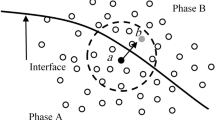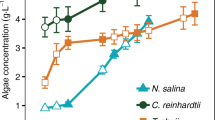Abstract
The three-dimensional distribution (x, y, and z) of ultrasound-induced microalgal cell disruption in a sonochemical reactor was predicted by solving the Helmholtz equation using a three-dimensional acoustic module in the COMSOL Multiphysics software. The simulated local ultrasound pressure at any given location (x, y, and z) was found to correlate with cell disruption of a freshwater alga, Scenedesmus dimorphus, represented by the change of algal cell particle/debris concentration, chlorophyll-a fluorescence density (CAFD), and Nile red stained lipid fluorescence density (LFD), which was also validated by the model reaction of potassium iodide oxidation (the Weissler reaction). Furthermore, the effect of ultrasound power intensity and processing duration on algal cell disruption was examined to address the limitation of the model.







Similar content being viewed by others
References
Chisti, Y. (2007). Biodiesel from microalgae. Biotechnology Advances, 25(3), 294–306.
Donohue, T. J., & Cogdell, R. J. (2006). Microorganisms and clean energy. Nature Reviews Microbiology, 4(11), 800.
Schenk, P. M., Thomas-Hall, S. R., Stephens, E., Marx, U. C., Mussgnug, J. H., Posten, C., Kruse, O., & Hankamer, B. (2008). Second generation biofuels: high-efficiency microalgae for biodiesel production. Bioenergy Research, 1(1), 20–43.
Baumgarten, E., Nagel, M., & Tischner, R. (1999). Reduction of the nitrogen and carbon content in swine waste with algae and bacteria. Applied Microbiology and Biotechnology, 52(2), 281–284.
Benemann, J. R. (1997). CO2 mitigation with microalgae systems. Energy Conversion and Management, 38, S475–S479.
Rodríguez-Ruiz, J., Belarbi, E. H., Sánchez, J. L. G., & Alonso, D. L. (1998). Rapid simultaneous lipid extraction and transesterification for fatty acid analyses. Biotechnology Techniques, 12(9), 689–691.
Ma, B., Chen, Y., Hao, H., Wu, M., Wang, B., Lv, H., & Zhang, G. (2005). Influence of ultrasonic field on microcystins produced by bloom-forming algae. Colloids and Surfaces B: Biointerfaces, 41(2), 197–201.
Adam, F., Abert-Vian, M., Peltier, G., & Chemat, F. (2012). “Solvent-free” ultrasound-assisted extraction of lipids from fresh microalgae cells: a green, clean and scalable process. Bioresource Technology, 114, 457–465.
Wu, X., Joyce, E. M., & Mason, T. J. (2012). Evaluation of the mechanisms of the effect of ultrasound on Microcystis aeruginosa at different ultrasonic frequencies. Water Research, 46(9), 2851–2858.
Joyce, E., Phull, S. S., Lorimer, J. P., & Mason, T. J. (2003). The development and evaluation of ultrasound for the treatment of bacterial suspensions. A study of frequency, power and sonication time on cultured Bacillus species. Ultrasonics Sonochemistry, 10(6), 315–318.
Keil, F. J., & Dahnke, S. (1997). Numerical calculation of pressure fields in sonochemical reactors—linear effects in homogeneous phase. Chemical Engineering, 41(1), 41–55.
Dähnke, S., & Keil, F. J. (1998). Modeling of three-dimensional linear pressure fields in sonochemical reactors with homogeneous and inhomogeneous density distributions of cavitation bubbles. Industrial & Engineering Chemistry Research, 37(3), 848–864.
Saez, V., Frías-Ferrer, A., Iniesta, J., González-García, J., Aldaz, A., & Riera, E. (2005). Characterization of a 20 kHz sonoreactor. Part I: analysis of mechanical effects by classical and numerical methods. Ultrasonics Sonochemistry, 12(1), 59–65.
Sutkar, V. S., Gogate, P. R., & Csoka, L. (2010). Theoretical prediction of cavitational activity distribution in sonochemical reactors. Chemical Engineering Journal, 158(2), 290–295.
Csoka, L., Katekhaye, S. N., & Gogate, P. R. (2011). Comparison of cavitational activity in different configurations of sonochemical reactors using model reaction supported with theoretical simulations. Chemical Engineering Journal, 178, 384–390.
Weissler, A., Cooper, H. W., & Snyder, S. (1950). Chemical effect of ultrasonic waves: oxidation of potassium iodide solution by carbon tetrachloride. Journal of the American Chemical Society, 72(4), 1769–1775.
Suslick, K. S., Mdleleni, M. M., & Ries, J. T. (1997). Chemistry induced by hydrodynamic cavitation. Journal of the American Chemical Society, 119(39), 9303–9304.
Gogate, P. R., Shirgaonkar, I. Z., Sivakumar, M., Senthilkumar, P., Vichare, N. P., & Pandit, A. B. (2001). Cavitation reactors: efficiency assessment using a model reaction. AIChE Journal, 47(11), 2526–2538.
Asakura, Y., Nishida, T., Matsuoka, T., & Koda, S. (2008). Effects of ultrasonic frequency and liquid height on sonochemical efficiency of large-scale sonochemical reactors. Ultrasonics Sonochemistry, 15(3), 244–250.
Moholkar, V. S., Sable, S. P., & Pandit, A. B. (2000). Mapping the cavitation intensity in an ultrasonic bath using the acoustic emission. AIChE Journal, 46(4), 684–694.
Gogate, P. R., Tatake, P. A., Kanthale, P. M., & Pandit, A. B. (2002). Mapping of sonochemical reactors: review, analysis, and experimental verification. AIChE Journal, 48(7), 1542–1560.
Wang, M., Yuan, W., Jiang, X., Jing, Y., & Wang, Z. (2014). Disruption of microalgal cells using high-frequency focused ultrasound. Bioresource Technology, 153, 315–321.
Wang, M., & Yuan, W. (2015). Microalgal cell disruption via ultrasonic nozzle spraying. Applied Biochemistry and Biotechnology, 175(2), 1111–1122.
Wang, M., & Yuan, W. (2015). Microalgal cell disruption in a high-power ultrasonic flow system. Bioresource Technology, 193, 171–177.
Tomita, Y., Robinson, P. B., Tong, R. P., & Blake, J. R. (2002). Growth and collapse of cavitation bubbles near a curved rigid boundary. Journal of Fluid Mechanics, 466, 259–283.
Bremond, N., Arora, M., Dammer, S. M., & Lohse, D. (2006). Interaction of cavitation bubbles on a wall. Physics of Fluids (1994–Present), 18(12), 121505.
Brennen, C. E. (2013). Cavitation and bubble dynamics. Cambridge: Cambridge University Press.
Ishida, H., Nuntadusit, C., Kimoto, H., Nakagawa, T., Yamamoto, T. (2001). Cavitation behavior near solid boundaries. In Proceedings of CAV 2001 4th International Symposium on Cavitation.
Wang, M., & Yuan, W. (2016). Modeling bubble dynamics and radical kinetics in ultrasound induced microalgal cell disruption. Ultrasonics Sonochemistry, 28, 7–14.
Matile, P., Hörtensteiner, S., & Thomas, H. (1999). Chlorophyll degradation. Annual Review of Plant Biology, 50(1), 67–95.
Gogate, P. R., Wilhelm, A. M., & Pandit, A. B. (2003). Some aspects of the design of sonochemical reactors. Ultrasonics Sonochemistry, 10(6), 325–330.
Sutkar, V. S., & Gogate, P. R. (2009). Design aspects of sonochemical reactors: techniques for understanding cavitational activity distribution and effect of operating parameters. Chemical Engineering Journal, 155(1), 26–36.
Gogate, P. R., & Pandit, A. B. (2000). Engineering design method for cavitational reactors: I. Sonochemical reactors. AIChE Journal, 46(2), 372–379.
Hua, I., Hochemer, R. H., & Hoffmann, M. R. (1995). Sonochemical degradation of p-nitrophenol in a parallel-plate near-field acoustical processor. Environmental Science & Technology, 29(11), 2790–2796.
Sivakumar, M., & Pandit, A. B. (2001). Ultrasound enhanced degradation of Rhodamine B: optimization with power density. Ultrasonics Sonochemistry, 8(3), 233–240.
Zhang, G., Zhang, P., & Fan, M. (2009). Ultrasound-enhanced coagulation for Microcystis aeruginosa removal. Ultrasonics Sonochemistry, 16(3), 334–338.
Acknowledgments
This research was financially supported by the US National Science Foundation (Award No. CMMI-1239078) and the startup fund of North Carolina State University.
Author information
Authors and Affiliations
Corresponding author
Rights and permissions
About this article
Cite this article
Wang, M., Yuan, W. & Hale, A. Three-Dimensional Simulation of Ultrasound-Induced Microalgal Cell Disruption. Appl Biochem Biotechnol 178, 1184–1195 (2016). https://doi.org/10.1007/s12010-015-1937-z
Received:
Accepted:
Published:
Issue Date:
DOI: https://doi.org/10.1007/s12010-015-1937-z




